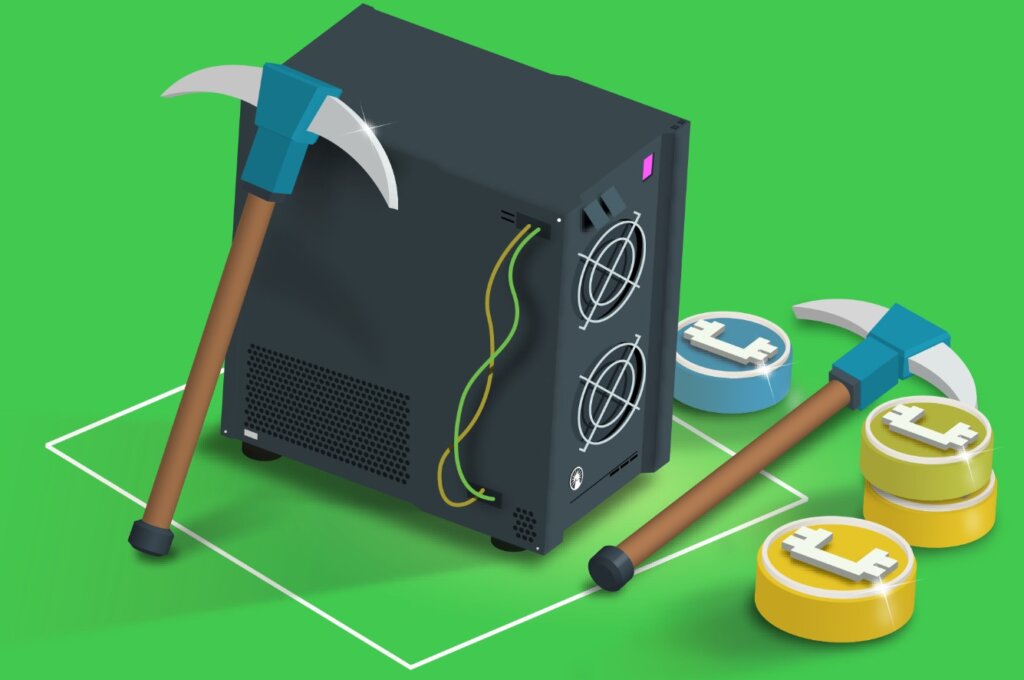Earning cryptocurrency can be done through various methods, and the approach you choose depends on your skills, resources, and preferences. Here are five general steps to help you get started:
- Educate Yourself:
Before diving into the world of cryptocurrency, it’s crucial to understand the basics. Learn about different cryptocurrencies, blockchain technology, and how to store and manage your digital assets securely. There are numerous online resources, forums, and courses available to help you gain knowledge. - Choose a Method:
Decide on a method for earning cryptocurrency that aligns with your skills and interests. Some common methods include:
- Mining: If you have the technical knowledge and the right hardware, you can mine certain cryptocurrencies.
- Trading: Buy and sell cryptocurrencies on exchanges to profit from market fluctuations.
- Freelancing: Offer your services and get paid in cryptocurrency. Many platforms support crypto payments for freelancers.
- Staking: If you hold certain cryptocurrencies in a wallet, you may be able to earn rewards by participating in the network’s staking process.
- Airdrops and Faucets: Participate in airdrops (free distributions of new cryptocurrencies) or use faucets that give away small amounts of crypto for completing simple tasks.
- Create a Wallet:
Set up a secure cryptocurrency wallet to store the digital assets you earn. Choose a wallet that fits your needs, whether it’s a hardware wallet for long-term storage or a software wallet for more frequent transactions. - Join a Cryptocurrency Exchange:
If you plan to trade or convert your cryptocurrency earnings into fiat currency, you’ll need to join a reputable cryptocurrency exchange. Research and choose an exchange that suits your requirements and has a good reputation for security. - Stay Informed and Secure:
Cryptocurrency markets are dynamic, and it’s essential to stay informed about market trends, news, and potential opportunities or risks. Additionally, prioritize security by enabling two-factor authentication on your accounts, using secure passwords, and keeping your private keys safe.
Here are 10 best earning sites where you may easily earn crypto!
As of my last knowledge update in January 2022, I don’t have specific information on the “best” cryptocurrency earning sites, as the cryptocurrency landscape is constantly evolving and the status of platforms can change.
However, I can provide you with a list of reputable platforms that were well-regarded for various cryptocurrency-related activities. Please note that you should always conduct your own research and verify the current status of these platforms, as circumstances can change rapidly in the cryptocurrency space. Here are ten platforms that were known for different cryptocurrency-related activities:
Earn.com (by Coinbase)
Remember to be cautious and conduct thorough research before using any platform. Cryptocurrency-related activities come with risks, and it’s crucial to prioritize security and use reputable services. Additionally, consider checking for more recent reviews and updates to ensure the continued reliability of these platforms.
Remember that the cryptocurrency market can be volatile, and there are risks associated with any method of earning crypto. Only invest time and money that you can afford to lose, and consider consulting with financial or investment professionals for personalized advice.
In the world of digital currencies, cryptocurrency mining has developed as a vital cycle, fueling the decentralized concept of these inventive monetary frameworks. Yet, what specifically is cryptocurrency mining, and how can it support the operations of cryptocurrencies like Bitcoin and Ethereum? How about we go into this lovely notion and untangle its complicated components?
- Unveiling the Essence of Cryptocurrency Mining
Cryptocurrency mining, commonly compared to digital gold mining, comprises employing powerful PCs to settle complicated numerical puzzles. These riddles, called cryptocurrency hashes, operate as the establishment for allowing transactions and acquiring the blockchain network. The main miner to properly answers the puzzle is awarded with gleaming new cryptocurrency tokens, comparable to uncovering rich metals in the classic mining procedure.
What is Cryptocurrency Mining?
Cryptocurrency mining is the most frequent technique of validating and authorizing trades on a blockchain network, the distributed record that enables digital forms of money. It comprises using specific PCs to take care of mind-boggling numerical challenges, a cycle known as “verification of work.” The first miner to handle the issue properly gets awarded with sparkling new digital currency coins.
- The Blockchain Spine: Guaranteeing Organization Respectability
Blockchain innovation, the secret core of digital currencies, acts as a circulating record, preserving a plain and precisely structured record, everything being equal. Cryptocurrency mining performs a crucial function in safeguarding the reliability of this record by authenticating the authenticity of every trade.
- The Miner’s Award: Incentives for Participation
Miners are made up for their computational attempts with glittering new cryptocurrency tokens, offering a monetary reason for their investment. This reward structure increases the decentralization of the organization, guaranteeing that no solitary substance retains undue command over the blockchain.
- The Advancement of Cryptocurrency Mining: From Home-Based Hobby to Industrial-Scale Operations
In the beginning of digital money, mining was a usually direct cycle that might be lead utilizing PCs. Nonetheless, when the intricacy of cryptographic algorithms grew, specialized mining equipment developed, prompting the foundation of enormous-scope mining activities.
- The Natural Impression of Cryptocurrency Mining: A Reason to Worry
The energy-escalated nature of Bitcoin mining has sparked questions about its environmental effect. The excessive power use of mining operations has sparked banters concerning the maintainability of this training.
- Emerging Trends in Cryptocurrency Mining: Exploring Sustainable Solutions
Because of natural anxieties, the Bitcoin community is successfully seeking manageable answers for mining operations. These arrangements encompass employing environmentally friendly power sources, expanding equipment effectiveness, and producing optional agreement components that demand less computing power.
The Motivation behind Cryptocurrency Mining

Cryptocurrency mining meets a few major purposes inside the decentralized blockchain biological system:
Transaction Verification: Miners certify the legitimacy of exchanges by examining the sender’s balance, assuring the absence of double-spending, and affirming the transaction’s conformance to the rules.
Block Generation: When a miner effectively confronts a cryptographic challenge, they are paid with the ability to add another block to the blockchain. This block includes a record of ongoing exchanges, widening the blockchain’s history.
Network Security: The serious notion of mining helps excavators to stay up with the organization’s honesty. Aggressors would have to control a substantial percentage of the organization’s mining capabilities to control the blockchain, making it incredibly secure.
- Why is Cryptocurrency Mining Important?
Cryptocurrency mining answers a few fundamental demands in the working of computerized monetary forms:
- Transaction Verification: Miners fastidiously validate each trade on the blockchain, assuring the reliability and authenticity of the company. They prevent double-spending, a circumstance when equivalent Bitcoin units are spent two times.
- Network Security: Mining improves the security of the blockchain by making it computationally infeasible to interfere with or control trade data. This decentralized agreement structure defends the organization against malignant assaults.
- New Coin Generation: In return for their computational attempts, excavators obtain newly generated digital currency coins. This cycle puts fresh currencies into flow while at the same time raising excavators to stay up with the organization’s security and productivity.
- How Does Cryptocurrency Mining Work?
The process of Cryptocurrency mining comprises a few major stages:
- Setting Up Mining Equipment: Miners employ specialist PCs, known as mining rigs, outfitted with strong graphics processing units (GPUs) or application-specific integrated circuits (ASICs) to take care of complicated numerical challenges.

- Joining a Mining Pool: Miners commonly pool their assets by joining a mining pool, pooling their computing capacity to increase their possibilities taking care of the challenges, and receiving rewards.

- Solving Numerical challenges: Miners routinely take care of complex numerical challenges, otherwise called “blocks,” employing their unique tools. The main miner to settle a block earns the award and publishes the solution to the network.
- Verifying Transactions: When a block is solved, the exchanges inside that block are reviewed and recorded to the blockchain, the permanent record of all transactions
- Getting incentives: Successful miners obtain cryptocurrency incentives in the form of newly produced coins, encouraging their participation in the organization’s assistance.
- How to Mine Cryptocurrency: A Step-by-Step Guide
Cryptocurrency mining has evolved into a well-known strategy for acquiring digital currency, although it tends to be a puzzling cycle to start things rolling. This tutorial will coach you through the means of the most excellent way to mine cryptocurrency, from acquiring the proper equipment to setting up your mining programs.
- Stage 1: Pick the Right Cryptocurrency to Mine
There are different cryptocurrencies that you may mine, each with its own innovative calculation and challenge level. Some of the most popular coins to mine include:
Bitcoin (BTC): The first and most recognized cryptocurrency, Bitcoin is therefore one of the most challenging to mine.
Ethereum (ETH): The second-most renowned cryptocurrency, Ethereum is somewhat more easy to mine than Bitcoin.
Monero (XMR): A privacy-focused cryptocurrency, Monero is recognized for its ASIC resistance, which makes it simpler to mine with GPUs.
Litecoin (LTC): A speedier and lighter solution in contrast to Bitcoin, Litecoin is a smart decision for newcomers.
Dogecoin (DOGE): A meme-based cryptocurrency, Dogecoin is a well-known option for miners because of its low difficulty level.
- Stage 2: Pick the Right Mining Equipment
The sort of mining equipment you desire will vary on the coin you need to mine. For Bitcoin and Ethereum, you will require specific equipment called ASICs.
For other digital currencies, you can leverage GPUs or computer CPUs.
ASICs: Application-specific coordinated circuits are planned explicitly for mining digital money. They are quite robust and effective, although they may likewise be pricey. C
GPUs: Graphics processing units are not as powerful as ASICs, but they are more reasonable and may in any event be used to mine an assortment of cryptocurrencies. D
CPUs: Central processing units are the least option for mining digital money, however, they are the most affordable. They are merely incredibly practical for mining a number of explicit digital currencies.

- Stage 3: Set Up Your Mining Software
There are different mining software applications accessible. The very most well-known alternatives include:
CGMiner: A lightweight and simple-to-utilize mining software tool.
EasyMiner: A beginner-friendly mining programming application that sustains a variety of coins.
MinerGate: A cloud mining stage that lets you to mine cryptocurrencies without putting up your own equipment.
- Stage 4: Join a Mining Pool
Joining a mining pool might aid you in broadening your options for earning rewards. At the time when you join a mining pool, you pool your assets with multiple miners and divide the benefits according to your participation.
- Stage 5: Begin Mining
Whenever you have set up your mining equipment and code, you may begin cryptocurrency mining. How much bitcoin you receive will vary upon your equipment, the cryptocurrency you are mining, and the difficulty level of the mining pool.
Extra Considerations
Electricity costs: Mining cryptocurrency might be energy-escalated, therefore it is necessary to assess the expense of electricity while selecting whether or not to mine.
Hardware maintenance: Mining equipment may be pricey, thus it is necessary to have your equipment very well kept up to increase its life expectancy.
Taxes: Cryptocurrency revenues are recognized as available pay in various purviews. Make certain to contact an expense counsel to find out about your obligation commitments.
- Is Cryptocurrency Mining Beneficial?
Whether cryptocurrency mining is fruitful rests upon numerous aspects, including the expenditure of electricity, the cost of the digital currency, and the difficulty level of the mining pool. By and large, is more useful when the cost of the cryptocurrency is high and the difficulty level is low.
The Effect of Cryptocurrency Mining
Cryptocurrency mining fundamentally impacts multiple areas of the digital currency ecosystem:
- Environmental Concerns: Mining uses huge measures of power, creating issues about its ecological influence. In any way, the firm is persistently researching more inexpensive mining rehearses.
- Financial Effect: Mining helps to the monetary development of locations with reduced power expenses, bringing in excavators and setting out company open doors.
- Technological improvement: Mining spurs improvement in equipment and software development, pushing the boundaries of computing power and productivity.
- Exploring the Future of Cryptocurrency Mining: An Investigation of Arising Trends and Potential Transformations
In the continually growing realm of digital currencies, cryptocurrency mining has cemented itself as a basis of the decentralized ecosystem. As the innovation grows and the scene changes, the final fate of cryptocurrency mining is poised to go through significant motions, shaping the path of this unprecedented monetary upheaval.
Arising Trends Reshaping the Cryptocurrency Mining Landscape
- Algorithmic Shifts: A Move Past Evidence of Work
The energy-concentrated nature of typical proof-of-work (PoW) agreement systems has raised questions about the ecological effect of cryptocurrency mining. Thus, voluntary agreement tools, such proof of stake (PoS), are picking up some forward momentum. PoS computations depend on validators designating their bitcoin money property to obtain the organization, lowering energy utilization without losing security.
- Cloud Mining: Availability and Productivity
Cloud mining administrations are arising as a suitable option in contrast to conventional mining arrangements. These administrations let people to lease mining power from faraway data centers, reducing the need for unique equipment and accompanying forthright charges. This shift could democratize mining investment and improve openness.
- Specialization and Enhancement: Adjusting to Changing Elements
As mining difficulty grows and competition intensifies, miners are gradually acquiring real expertise in mining specified coins. This expertise addresses designated improvement and asset distribution, boosting effectiveness and productivity. Furthermore, miners are widening their portfolios by mining many digital kinds of money to reduce dangers associated to cost adjustments.
- Reasonable Mining Practices: Addressing Environmental Concerns
The natural consequence of cryptocurrency mining remains a hostile problem. In any event, the firm is effectively studying supportable mining rehearses, for example, employing environmentally friendly power sources and utilizing energy-proficient mining equipment. These initiatives aim to lessen the carbon impact of mining operations and match up with the more extensive maintainability objectives of the digital money environment.
- Regulatory Landscape: Exploring Developing Structures
Governments worldwide are wrestling with the administrative repercussions of cryptocurrency mining. As rules improve, excavators should adapt their operations to fit to the neighborhood and worldwide demands. This might entail carrying out stronger know-your-customer (KYC) and anti-money laundering (AML) measures, as well as abiding by energy proficiency guidelines.
Potential Changes Forming the Future of Cryptocurrency Mining
- Decentralized Autonomous Organizations (DAOs): Administration and Resource Allocation
DAOs might appear as an amazing power in cryptocurrency mining, permitting excavators to all things considered govern mining pools, dispense assets, and convey prizes. This decentralized administration strategy might boost straightforwardness, competence, and dynamics inside the mining environment.
- Artificial Intelligence (AI) and Machine Learning (ML): Improvement and Proficiency
The combination of AI and ML might revolutionize cryptocurrency mining activity. Artificial intelligence calculations might update mining methods, forecast market drifts, and computerized navigation, encouraging enhanced effectiveness and productivity. ML might also be applied to encourage better energy-proficient mining computations and equipment.
- Quantum Computing: Potential Disruptions and Advancements
The emergence of quantum computing raises two problems and creates openings for cryptocurrency mining. While quantum PCs may genuinely overcome present encryption computations, they could also drive the development of safer and more productive mining conventions.
- Hybrid Mining Models: Consolidating Different Agreement Systems
Hybrid mining models might evolve, merging PoW with PoS or other agreement components. This strategy might increase security, energy productivity, and adaptability, tending to the constraints of individual agreement computations.
- Tokenized Mining: Fractional Ownership and Democratization
Tokenizing mining power might democratize collaboration in the mining system. By fractionalizing mining holdings into tokens, users might put resources into mining operations without the necessity for certain equipment or expert ability.
End: Embracing Development and Exploring Uncertainties
The future fate of cryptocurrency mining is ready for significant adjustments, pushed by inventive headways, administrative twists of events, and the progressing requirements of the digital currency ecosystem. As the firm adjusts and develops, the task of bitcoin mining will carry on expanding, sculpting the decentralized monetary scene, and reflecting things to come.

